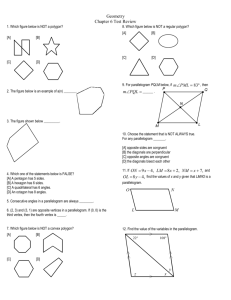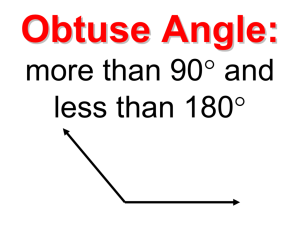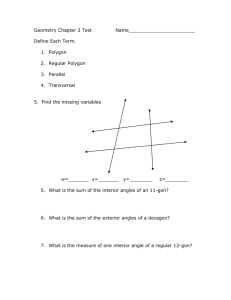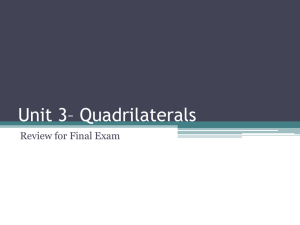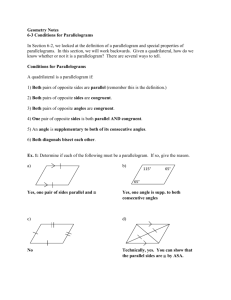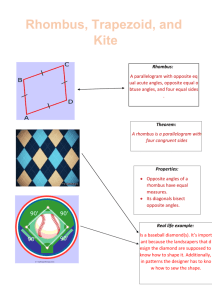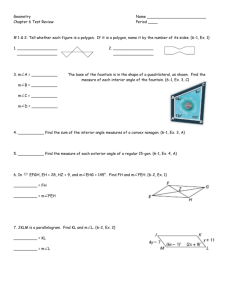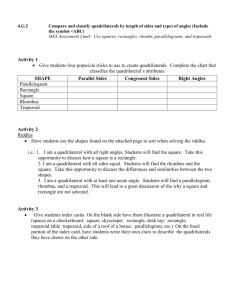Unit 8
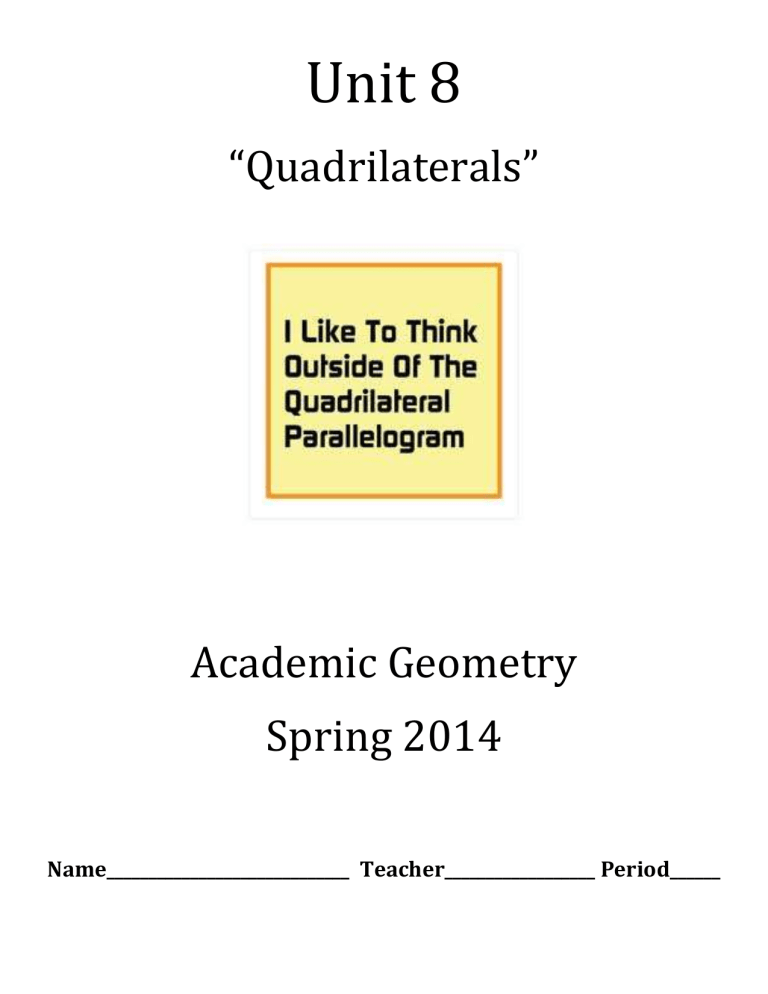
Unit 8
“Quadrilaterals”
Academic Geometry
Spring 2014
Name_____________________________ Teacher__________________ Period______
1
2
3
Unit 8 at a glance
“Quadrilaterals”
This unit focuses on revisiting prior knowledge of polygons and extends to formulate, test, and apply conjectures about quadrilaterals. Students will be able to identify quadrilaterals by the given properties and apply the properties to solve both purely mathematical and real world situations.
Essential Questions
How are polygons related? What properties do they share?
What are the differences and similarities between the types of quadrilaterals (square, rectangle, rhombus, parallelogram, trapezoid, and kite)? And how does knowing this help me?
In Unit 8, students will…
Apply the terms convex, concave, n-gon, equilateral, equiangular, and regular to describe polygons when solving problems involving area, perimeter and circumference in both real-world and purely mathematical situations;
Formulate, test, and apply conjectures (based on explorations and concrete models) involving the sum of the measures of interior and exterior angles of convex polygons and the measures of each interior and exterior angle of a regular polygon to solve problems in both real-world and purely mathematical situations;
Formulate, test, and apply conjectures (based on explorations and concrete models) involving the properties of parallelogram (including angle and side measure relationships) to solve problems in both real-world and purely mathematical situations;
Formulate, test, and apply conjectures (based on explorations and concrete models) involving the conditions that ensure a quadrilateral is a parallelogram including opposite side, opposite angle and diagonal relationships and solve problems in both real-world and purely mathematical situations requiring axiomatic and coordinate approaches;
Formulate, test, and apply conjectures (based on explorations and concrete models) involving the properties of rhombuses, rectangles and squares to solve problems in both real-world and purely mathematical situations;
4
Formulate, test, and apply conjectures (based on explorations and concrete models) involving the properties of trapezoids and kites to solve problems in both real-world and purely mathematical situations requiring axiomatic or coordinate geometry approaches;
Compare and contrast quadrilaterals (parallelograms, rhombuses, rectangles, squares, trapezoids, kites) and their properties to identify them and to solve problems in both real-world and purely mathematical situations.
5
concave polygons convex polygons diagonal equiangular exterior angles interior angles isosceles trapezoid kite midsegment n-gons opposite angle parallelogram quadrilateral rectangle regular polygons rhombus square trapezoid vertices
Vocabulary
6
7
Meet the Quadrilateral Family
*
Quadrilateral
I have exactly four sides.
* Parallelogram
The sum of my interior angles is 360 0 .
I have:
- 2 sets of parallel sides
- 2 sets of congruent sides
- opposite angles congruent
- consecutive angles supplementary
- diagonals bisect each other
- diagonals form 2 congruent triangles
*
Rhombus
I have all of the properties of the parallelogram PLUS
- 4 congruent sides
- diagonals bisect angles
- diagonals perpendicular
* Rectangle
I have all of the properties of the parallelogram PLUS
- 4 right angles
- diagonals congruent
* Square
Hey , look at me!
I have all of the properties of the parallelogram
AND the rectangle AND the rhombus.
I have it all!
* Trapezoid
I have only one set of parallel sides.
*
Isosceles Trapezoid
I have:
- only one set of parallel sides
- base angles congruent
- legs congruent
* Kite
I have:
- 2 sets of consecutive congruent sides
- only one pair of opposite angles congruent
- diagonals perpendicular
- diagonals congruent
- opposite angles supplementary
8
9
8.1 NOTES
Essential Vocabulary
Polygon
Concave Convex
Not Polygons
Equilateral Equiangular Regular
Triangle
Quadrilateral
Pentagon
Hexagon
Heptagon
Octagon
Nonagon
Decagon
Dodecagon
n-gon (an n-sided shape)
ANY shape can be called “n”-gon based on the number of sides. Polygons with more than 10 sides are usually referred to as
“n”-gons
Ex. 14-gon, 32-gon, 100-gon
10
Interior and Exterior Angles of a Polygon
In a polygon, two vertices that are endpoints of the same side are called consecutive
vertices. A diagonal of a polygon joins two non-consecutive vertices of a polygon.
Consecutive vertices
Choose any vertex and draw every diagonal possible from that vertex.
Notice that when you draw all the diagonals of a polygon from one vertex, you divide the polygon into ___________________________________. Recall that the triangle sum theorem states
_____________________________________________________________________________________________________.
For each polygon in the table, draw all the diagonals from one vertex. Complete the table.
Polygon # of Sides
# of triangles formed
Interior Angle
Sum of Polygon
Triangle
Quadrilateral
Pentagon
Hexagon
Heptagon
n-gon
11
POLYGON INTERIOR ANGLES THEOREM:
For an n-sided convex polygon, the sum of all the interior angles is ____________________.
The exterior angle sum of a polygon does not depend on the number of sides on the polygon. To prove this, use the diagrams below to calculate each exterior angle of the polygons. Remember that an interior angle and its adjacent exterior angle form a linear pair (so their sum is ___________).
triangle quadrilateral pentagon
85⁰ 110⁰ 130⁰
50⁰
125⁰ 115⁰ 85⁰
55⁰
90⁰ 40⁰ 95⁰ 100⁰
Interior angle sum
180⁰ 360⁰ 540⁰
Exterior angle sum
POLYGON EXTERIOR ANGLES THEOREM:
The sum of all the exterior angles of a convex polygon (one exterior angle at each vertex is always ________________________.
Example 1:
Find the sum of the measures of the interior angles of a convex octagon.
Example 2:
The sum of the measures of the interior angles of a convex polygon is 1440⁰. How many sides does the polygon have?
12
Example 3:
Find the value of x .
Example 5:
Find the value of x .
Example 4:
A trampoline is shaped like a regular dodecagon (12 sides). Find the measure of each interior and exterior angle.
13
8.1 HOMEWORK
Find the sum of the measures of the interior angles of the indicated convex polygon.
1.
11-gon 2. 40-gon
The sum of the measures of the interior angles of a convex polygon is given. Classify the polygon by the number of sides.
3.
180°
4.
540°
5.
3960°
Find the value of 𝒙 .
6.
7.
14
15
8.
The measures of the interior angles of a convex octagon are
45𝑥°, 40𝑥°, 155°, 120°, 155°, 38𝑥°, 158°, and 41𝑥°.
What is the measure of the smallest interior angle?
Find the measures of an interior angle and an exterior angle of the indicated polygon.
9.
Regular Octagon
10.
Regular 100-gon
11.
The side view of a storage shed is shown below. Find the value of 𝑥 . Then determine the measure of each angle.
8.2 NOTES
Properties of Parallelograms
DEFINITION: A parallelogram is a quadrilateral with __________________________________
_____________________________________________________________________________.
You can call this figure: “Parallelogram PQRS
In PQRS , QP RS and QR PS
” or.
, by definition.
Other properties: If a quadrilateral is a parallelogram, then….
THM 8.3
THM 8.4
THM 8.5
THM 8.6
Ex1: Find the values of x and y.
Ex 2:
Your thoughts:
1) Is it a parallelogram? YES, b/c the opp. sides are parallel (def.)
2) Opposite sides are congruent, so x + 4 = 12.
3) Opposite angles are congruent, so y = 65.
16
Ex 3-6:
Ex 7: The measure of one interior angle of a parallelogram is 50 degrees more than 4 times the measure of another angle. Find the measure of each angle.
(Make a sketch and label it.)
Ex 8: In LMNO , the ratio of LM to MN is 4:3. Find LM if the perimeter of LMNO is 28.
Ex 9: The diagonals of LMNO intersect at point P. What are the coordinates of P?
Hint: What do you need to know?
17
Ex 10: Is the quadrilateral formed by the lines on the graph a parallelogram?
Hint: What do you need to know?
18
19
Find the measure of the indicated angle in the parallelogram.
1.
Find 𝑚∠𝐺. 2. Find 𝑚∠𝑀.
Find the value of each variable in parallelogram.
3.
4.
Find the indicated measure in 𝑨𝑩𝑪𝑫.
5.
𝑚∠𝐴𝐸𝐵 =
6.
𝑚∠𝐴𝐸𝐷 =
7.
𝑚∠𝐵𝐴𝐷 =
8.
𝑚∠𝐴𝐷𝐶 =
8.2 HOMEWORK
20
Use the diagram of 𝑴𝑵𝑶𝑷.
Points 𝑸, 𝑹, 𝑺, and 𝑻 are midpoints of 𝑴𝑿, 𝑵𝑿, 𝑶𝑿, and
𝑷𝑿. Find the indicated measure.
9.
𝑃𝑁 =
10.
𝑋𝑂 =
11.
𝑚∠𝑁𝑀𝑄 =
12.
𝑚∠𝑁𝑂𝑃
13. In parallelogram 𝑅𝑆𝑇𝑈, the ratio of 𝑅𝑆 to 𝑆𝑇 is 5: 3 . Find 𝑅𝑆 if the perimeter of
𝑅𝑆𝑇𝑈 is 64 .
21
Examples:
Proving a Quadrilateral is a Parallelogram
8.3 NOTES
22
23
8.3 HOMEWORK
What theorem can you use to show that the quadrilateral is a parallelogram?
1.
2.
3.
4.
For what value of 𝒙 is the quadrilateral a parallelogram?
5.
6.
7.
8.
9.
10.
24
The vertices of quadrilateral 𝑨𝑩𝑪𝑫 are given. Draw 𝑨𝑩𝑪𝑫 in a coordinate plane and show that it is a parallelogram.
11.
𝐴(−2, −3), 𝐵(0, 5), 𝐶(6, 5), 𝐷(4, −3)
12.
𝐴(−3, −4), 𝐵(−1, 2), 𝐶(7, 0), 𝐷(5, −6)
25
Rhombuses, Squares and Rectangles
In this lesson, you will learn about three special types of parallelograms:
8.4NOTES
Rhombus
A parallelogram with four congruent sides
(equilateral).
Rectangle
A parallelogram with four right angles (equiangular).
Square
A parallelogram with four congruent sides and four right angles (regular).
SPECIAL NOTES ABOUT SQUARES:
Since a square has four congruent sides, it is also a _____________________________________ .
Since a square has four right angles, it is also a __________________________________________ .
Diagonals of Rhombuses and Rectangles
26
Examples:
Name each quadrilateral—parallelogram, rectangle, rhombus, and square—for which the statement is true.
1.
It is equiangular.
2.
It is equiangular and equilateral.
3.
It is diagonals are perpendicular.
4.
Opposite sides are congruent.
5.
The diagonals bisect each other.
6.
The diagonals bisect opposite angles.
Classify the special quadrilateral. Explain your reasoning.
Then find the values of 𝒙 and 𝒚 .
7.
8.
9.
In the rhombus to the right, given 𝑚∠1 = 31° . Find all the other angles. 𝑚∠2 = __________ 𝑚∠3 = __________ 𝑚∠4 = __________ 𝑚∠5 = __________
27
10.
Given rectangle CERT and 𝑚∠1 = 32° , find each measure. 𝑚∠2 = __________ 𝑚∠3 = __________ 𝑚∠4 = __________ 𝑚∠5 = __________
11.
Given rectangle CERT,
(1) If 𝑅𝑀 = 4𝑥 + 16 and 𝑀𝐸 = 108 , solve for 𝑥 .
(2) If 𝑚∠𝐶𝐸𝑀 = 𝑦 − 12° and 𝑚∠𝑅𝐸𝑀 = 62° , solve for 𝑦 .
28
29
30
31
8.4 HOMEWORK
For any rhombus 𝑨𝑩𝑪𝑫, decide whether the statement is always or sometimes true.
Draw a diagram and explain your reasoning.
1.
∠𝐴𝐵𝐶 ≅ ∠𝐶𝐷𝐴 2. 𝐶𝐴 ≅ 𝐷𝐵
For any rectangle 𝑭𝑮𝑯𝑱, decide whether the statement is always or sometimes true.
Draw a diagram and explain your reasoning.
4. 𝐺𝐻 ≅ 𝐻𝐽 3.
∠𝐹 ≅ ∠𝐻
Classify the quadrilateral. Explain your reasoning.
5.
6.
32
Classify the special quadrilateral. Explain your reasoning. Then find the values of 𝒙 and 𝒚.
7.
8.
The diagonals of rhombus 𝑷𝑸𝑹𝑺 intersect at 𝑻. Given that 𝒎∠𝑹𝑷𝑺 = 𝟑𝟎° and
𝑹𝑻 = 𝟔, find the indicated measure.
9.
𝑚∠𝑄𝑃𝑅 =
10.
𝑚∠𝑄𝑇𝑃 =
11.
𝑅𝑃 =
12.
𝑄𝑇 =
13.
In preparation for a storm, a window is protected by nailing boards along its diagonals. The lengths of the boards are the same. Can you conclude that the window is a square? Explain.
33
8.5/8.6 NOTES
Trapezoids & Kites
DEFINITION: A trapezoid is a quadrilateral with ________________________________________
_________________________________________________________________________________.
The parallel sides are called the __________________________________.
The non-parallel sides are called the __________________________________.
Since a trapezoid has two bases, it has two pairs of __________________________________.
DEFINITION: An isosceles trapezoid is one in which the __________________________________.
Think of it as an isosceles triangle with the “top” cut off by a segment parallel to a base.
*An isosceles trapezoid has:
(THM 8.14) ___________________________________________________
(THM 8.16)
___________________________________________________
34
DEFINITION: The midsegment of a trapezoid is a segment that connects the
____________________________ of its ____________________________.
(THM 8.17) The midsegment of a trapezoid is parallel to each base and measures on half the sum of the base lengths.
If MN is the midsegment of trapezoid 𝐴𝐵𝐶𝐷 , then MN ∥ AB, MN ∥ DC, and 𝑀𝑁 =
1
2
(𝐴𝐵 + 𝐶𝐷)
**In other words, 𝒎𝒊𝒅𝒔𝒆𝒈𝒎𝒆𝒏𝒕 = 𝒃𝒂𝒔𝒆
𝟏
+𝒃𝒂𝒔𝒆
𝟐
𝟐
Examples:
1.
Find 𝑚∠𝐽, 𝑚∠𝐿, and 𝑚∠𝑀 . 2. Find the length of the midsegment.
3.
Solve for 𝑥 .
35
4. In trapezoid 𝐽𝐾𝐿𝑀 , 𝐽𝐾 ∥ 𝐿𝑀 and 𝐽𝐾 = 17 .
The midsegment is 𝑋𝑌 𝑎𝑛𝑑 𝑋𝑌 = 37 .
Sketch 𝐽𝐾𝐿𝑀 and its midsegment and find 𝐿𝑀 .
DEFINITION: A kite is a quadrilateral with ____________________________________________________.
THREE RULES FOR KITES
36
37
UNIT 8 PERFORMANCE TASK
Performance of a Lifetime
You are a dance choreographer and have been asked by the Houston Rockets to come up with a 45 second dance that will be showcased during a playoff game. You have been allowed to use the entire court for the performance and have been asked to make sure that all sides of the viewing audience will be able to see the performance without using the
Jumbotron. Your goal is to fill the 94 x 50 foot court by placing the dancers in the shape of a polygon. You want to make sure that you use as much of the court as possible while making sure that there is an equal amount of unused space at each corner of the court.
1.
Determine where the vertices of your polygon must fall to develop an equal amount of unused space so all fans can see the performance and the owner of the Houston Rockets will be happy. How would you find these points and how do you know the unused space is equal at each corner of the court?
2. What type of polygon is created? How can you justify your answer? Justify all of the polygon’s properties.
38
39

